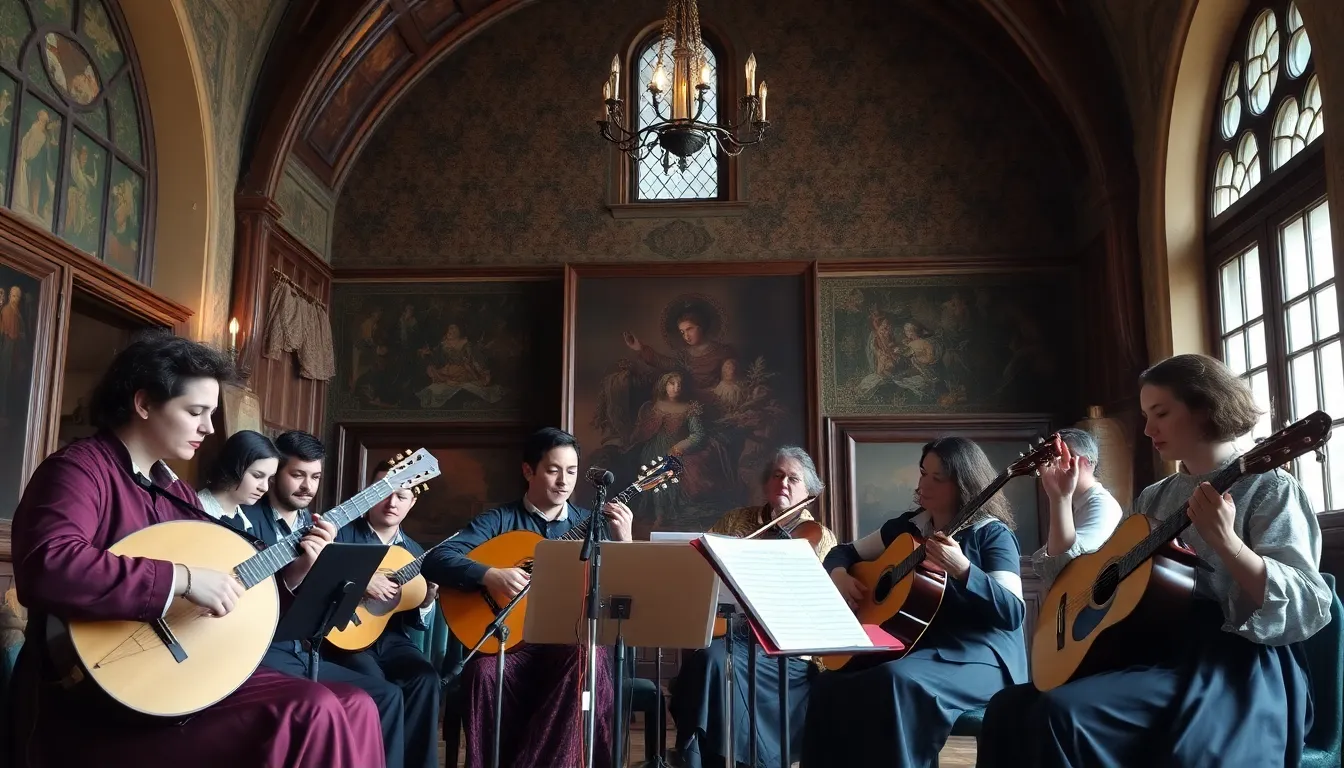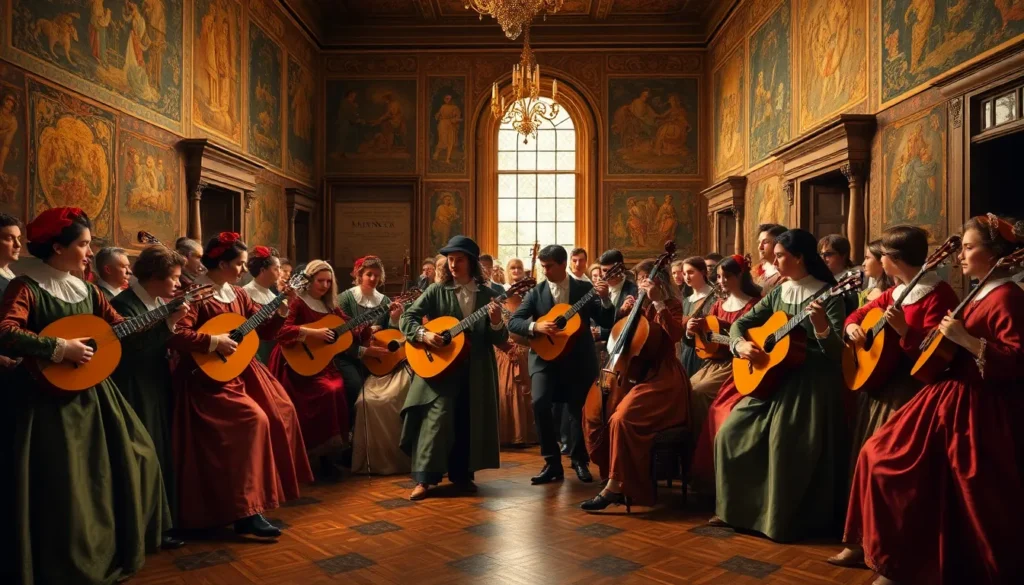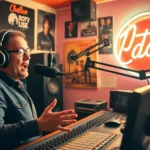Table of Contents
ToggleImagine stepping into a world where music dances through the air like a courtier at a royal ball. That’s the magic of Renaissance music, a vibrant tapestry woven between the 14th and 17th centuries. This era gifted the world with exquisite harmonies and innovative compositions that continue to inspire musicians today.
Overview Of Renaissance Music Pieces
Renaissance music features a rich variety of compositions that showcase the artistic advancements of the period. Among the most notable forms are choral works, instrumental pieces, and secular songs. Choral music, characterized by its use of polyphony, emphasizes the blending of multiple vocal lines. Composers like Josquin des Prez and Giovanni Pierluigi da Palestrina set high standards for choral writing. Palestrina’s “Missa Papae Marcelli” exemplifies the era’s devotion and grandeur.
Instrumental music flourished during this time, with the development of new instruments such as the lute and viola da gamba. The rise of consort music created opportunities for small groups of instruments to perform together. This shift not only enhanced musical textures but also expanded the repertoire available to musicians. Notable composers include John Dowland, whose lute compositions remain popular today.
Secular music also gained prominence, reflecting the everyday lives and emotions of people in the Renaissance. The use of madrigals allowed for intricate word painting, where composers conveyed textual meaning directly through musical phrases. Works like Thomas Morley’s “Now Is the Month of Maying” demonstrate the playful spirit of this genre.
A significant characteristic of Renaissance music is its focus on humanism, which placed emphasis on individual expression and emotion. This emphasis led to greater experimentation with harmony and melody. As a result, the period laid the groundwork for the transition to Baroque music.
Overall, Renaissance music pieces reflect the era’s innovations, emotional depth, and artistic achievements, making it a pivotal moment in the history of Western music.
Key Characteristics Of Renaissance Music


Renaissance music is defined by its intricate structures and expressive qualities. The era marked significant developments that influenced future musical compositions.
Harmony And Texture
Harmony played a crucial role in Renaissance music, reflecting the era’s evolving aesthetic. Composers utilized rich chords, often employing triads to create a fuller sound. The texture includes layers that interweave melody and harmony, resulting in a balanced sonic landscape. This period saw a shift from the simple monophonic textures of earlier times to more complex arrangements. Instrumental ensembles enhanced this richness, particularly in dance music and consorts.
Use Of Polyphony
Polyphony represents a hallmark of Renaissance music, showcasing the simultaneous combination of independent melodies. Multiple vocal lines interact harmoniously, creating a dialogue between parts. Composers such as Josquin des Prez exemplified this style, pushing the boundaries of melodic interplay. The use of imitation within polyphonic compositions allowed themes to resonate throughout the work. This technique not only demonstrated compositional skill but also captivated audiences, elevating choral music to new heights.
Notable Renaissance Composers
Renaissance music flourished due to the contributions of several key composers. Their innovative techniques and masterpiece compositions define the era’s rich musical landscape.
Josquin des Prez
Josquin des Prez stands out as a master of polyphony. He used intricate imitative counterpoint, allowing melodies to weave together seamlessly. Works like “Ave Maria… Virgo serena” showcase his skill in expressing emotion through music. His compositions feature a blend of sacred and secular themes. Des Prez’s influence on later composers is undeniable, as they sought to emulate his artistry and complex vocal structures.
Giovanni Pierluigi da Palestrina
Giovanni Pierluigi da Palestrina exemplifies the pinnacle of Renaissance sacred music. His work, notably “Missa Papae Marcelli,” represents the height of clarity and balance in choral writing. Palestrina emphasized smooth melodic lines that enhanced text comprehension, making his music highly accessible. His mastery of harmony and counterpoint influenced generations of composers. Many regarded his style as the model for sacred music, firmly establishing his legacy in music history.
Influential Renaissance Music Pieces
Renaissance music features a variety of influential pieces that shaped the era’s sound. Sacred and secular works reflect the richness and diversity of this period.
Sacred Works
Sacred music during the Renaissance emphasized vocal polyphony. Josquin des Prez’s “Ave Maria… Virgo serena” exemplifies the seamless interaction of voices, blending emotional depth with religious reverence. Giovanni Pierluigi da Palestrina’s “Missa Papae Marcelli” showcases clarity in text setting, making it easier for congregants to understand the lyrics. Composers employed intricate counterpoint techniques that invited listeners into a spiritual experience. Choral compositions during this time served both liturgical purposes and artistic expression, leaving a significant legacy in Western sacred music.
Secular Works
Secular music flourished alongside sacred compositions during the Renaissance. The madrigal, a dominant genre, conveyed everyday themes and human emotions. Thomas Morley’s “Now Is the Month of Maying” captures the playful spirit of spring with its lively rhythms and vocal interplay. Composers often incorporated elements of dialogue, showcasing a blend of voices that created an engaging atmosphere. Instrumental pieces also gained popularity, featuring the lute and viol. These works not only entertained but also reflected the societal shifts and growing individualism of the time, marking a pivotal transition in music history.
The Impact Of Renaissance Music On Later Eras
Renaissance music significantly shaped future musical traditions, bridging the gap between medieval and Baroque styles. Composers during the Renaissance laid the groundwork for harmony, polyphony, and expressive techniques that later influenced generations. By emphasizing human emotion, they introduced a nuanced approach to musical composition.
Innovation in instrumental music also had lasting effects. The introduction of instruments like the lute and viola da gamba transformed ensemble practices and broadened musical expression. As small groups of musicians began performing together, it contributed to the development of sophisticated orchestral music.
The techniques developed during this era directly influenced composers of the Baroque period. For instance, the use of counterpoint, refined by masters like Josquin des Prez and Palestrina, became fundamental for later composers such as Johann Sebastian Bach. Harmony grew richer and more complex, as Baroque composers adopted and expanded on Renaissance practices.
Renaissance secular music introduced new forms, such as madrigals, that inspired later vocal arrangements. Composers like Thomas Morley showcased how everyday themes in music could connect listeners emotionally. This approach to secular themes persisted into subsequent musical movements, emphasizing storytelling through song.
Vocal music’s emotive quality also set the stage for opera and the increased focus on drama in music. The shift from polyphony to a more homophonic texture marked a key transition that paved the way for later composers to explore greater emotional depth.
Thus, Renaissance music occupies a vital place in the history of Western music, establishing principles that endure in contemporary compositions. Its intricate balance of sacred and secular themes continues to resonate, leaving an indelible mark on the music that followed.
Renaissance music remains a cornerstone of Western musical heritage. Its intricate harmonies and innovative approaches not only shaped the music of its time but also laid the groundwork for future generations. The era’s emphasis on human expression and emotional depth continues to inspire musicians today.
As composers like Josquin des Prez and Palestrina pushed the boundaries of polyphony and texture, their influence can still be felt in contemporary compositions. The rich tapestry of sacred and secular works from this period highlights the enduring power of music to reflect the human experience. Renaissance music will always be celebrated for its artistry and its pivotal role in the evolution of music history.





